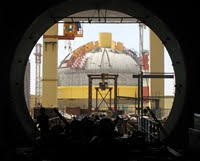Following the Nuclear Supplier Group's waiver in September 2008, India seems ready to take its place in the world of nuclear trade -- not just as a purchaser, but as a supplier, too. It appears that Kazakhstan is in line to be India's first customer for indigenously developed 220 megawatt electric (MWe) Pressurized Heavy Water Reactors (PHWRs). The proposed sale seems likely to follow the civil nuclear agreement signed by the two countries in January 2009. In addition to Kazakhstan, a number of Southeast Asian and African countries are also in serious talks with the Indian state-owned nuclear industry major, Nuclear Power Corporation of India Ltd (NPCIL), for possible reactor purchases. The sales would serve to underline that India will not be content to remain a mere recipient of nuclear technology, but has actually set its sights quite a bit higher.
During its 34-year "nuclear winter," India focused on attaining mastery over all aspects of nuclear energy. While it met with limited success in some areas, it attained world-class capability in others, one of them being small PHWR technology. The IAEA defines small reactors as those having a capacity of 300 MWe or less. Reactors of this size make great sense for countries with modest requirements -- of less than 10,000 MWe, for instance. Even a single 1,000 MWe reactor would be more of a liability for such countries, since any shutdown, routine or otherwise, cannot be handled by a small grid.
On the other hand, India's 220 MWe PHWRs fit nicely into such a picture, with an added selling point being that India operates more than a dozen such reactors itself, and has done so for over 30 years now. While the technology was initially reverse-engineered from CANDU reactors imported from Canada, India has innovated considerably on the safety and fuel efficiency of subsequent models. It has also made the technology cheaper, a crucial consideration for this type of reactor's potential buyers.

